Strategic Management the Australian Dairy Industry
VerifiedAdded on 2020/04/15
|16
|3540
|184
AI Summary
Contribute Materials
Your contribution can guide someone’s learning journey. Share your
documents today.

Running head: STRATEGIC MANAGEMENT
Strategic management
Name of student
Name of University
Author note
Strategic management
Name of student
Name of University
Author note
Secure Best Marks with AI Grader
Need help grading? Try our AI Grader for instant feedback on your assignments.
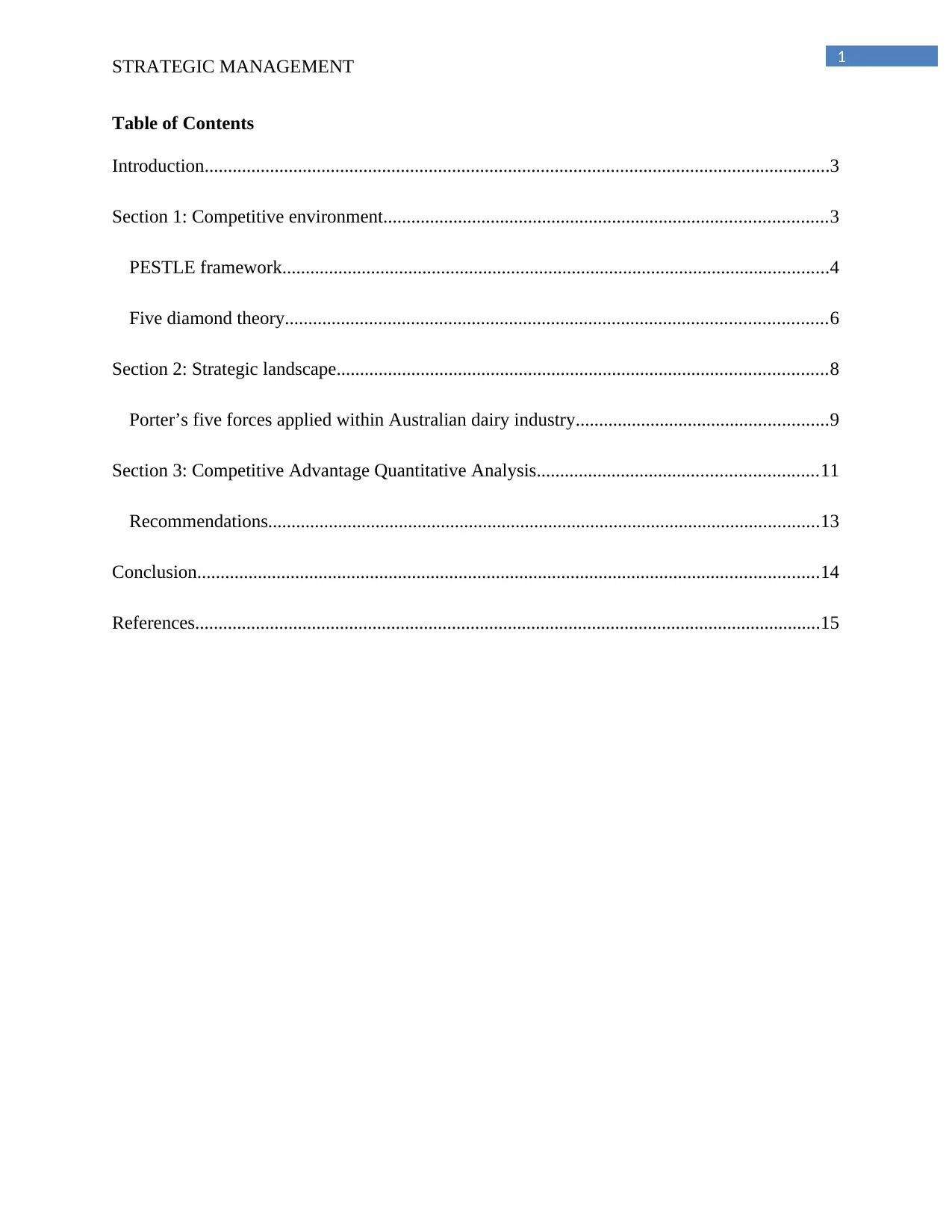
1
STRATEGIC MANAGEMENT
Table of Contents
Introduction......................................................................................................................................3
Section 1: Competitive environment...............................................................................................3
PESTLE framework.....................................................................................................................4
Five diamond theory....................................................................................................................6
Section 2: Strategic landscape.........................................................................................................8
Porter’s five forces applied within Australian dairy industry......................................................9
Section 3: Competitive Advantage Quantitative Analysis............................................................11
Recommendations......................................................................................................................13
Conclusion.....................................................................................................................................14
References......................................................................................................................................15
STRATEGIC MANAGEMENT
Table of Contents
Introduction......................................................................................................................................3
Section 1: Competitive environment...............................................................................................3
PESTLE framework.....................................................................................................................4
Five diamond theory....................................................................................................................6
Section 2: Strategic landscape.........................................................................................................8
Porter’s five forces applied within Australian dairy industry......................................................9
Section 3: Competitive Advantage Quantitative Analysis............................................................11
Recommendations......................................................................................................................13
Conclusion.....................................................................................................................................14
References......................................................................................................................................15
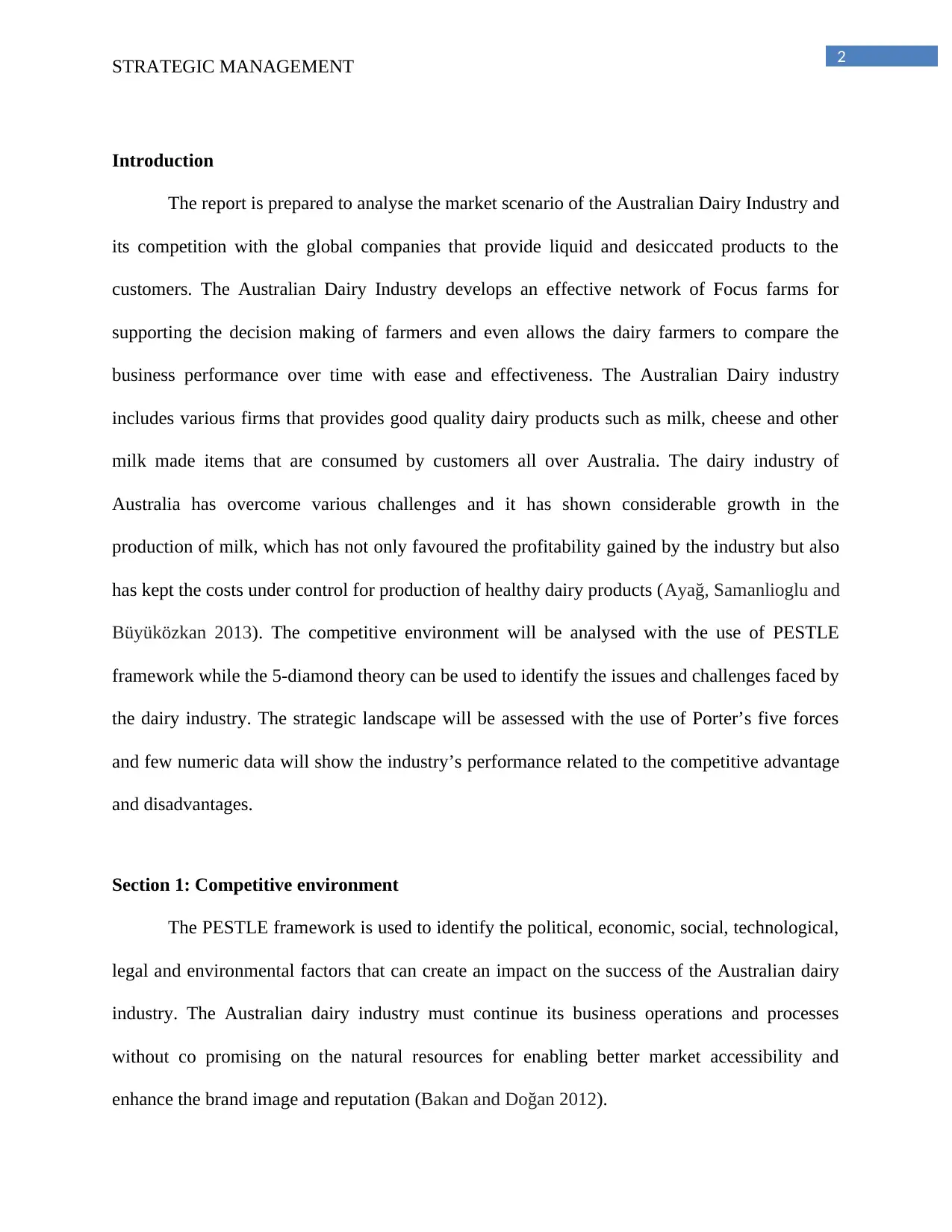
2
STRATEGIC MANAGEMENT
Introduction
The report is prepared to analyse the market scenario of the Australian Dairy Industry and
its competition with the global companies that provide liquid and desiccated products to the
customers. The Australian Dairy Industry develops an effective network of Focus farms for
supporting the decision making of farmers and even allows the dairy farmers to compare the
business performance over time with ease and effectiveness. The Australian Dairy industry
includes various firms that provides good quality dairy products such as milk, cheese and other
milk made items that are consumed by customers all over Australia. The dairy industry of
Australia has overcome various challenges and it has shown considerable growth in the
production of milk, which has not only favoured the profitability gained by the industry but also
has kept the costs under control for production of healthy dairy products (Ayağ, Samanlioglu and
Büyüközkan 2013). The competitive environment will be analysed with the use of PESTLE
framework while the 5-diamond theory can be used to identify the issues and challenges faced by
the dairy industry. The strategic landscape will be assessed with the use of Porter’s five forces
and few numeric data will show the industry’s performance related to the competitive advantage
and disadvantages.
Section 1: Competitive environment
The PESTLE framework is used to identify the political, economic, social, technological,
legal and environmental factors that can create an impact on the success of the Australian dairy
industry. The Australian dairy industry must continue its business operations and processes
without co promising on the natural resources for enabling better market accessibility and
enhance the brand image and reputation (Bakan and Doğan 2012).
STRATEGIC MANAGEMENT
Introduction
The report is prepared to analyse the market scenario of the Australian Dairy Industry and
its competition with the global companies that provide liquid and desiccated products to the
customers. The Australian Dairy Industry develops an effective network of Focus farms for
supporting the decision making of farmers and even allows the dairy farmers to compare the
business performance over time with ease and effectiveness. The Australian Dairy industry
includes various firms that provides good quality dairy products such as milk, cheese and other
milk made items that are consumed by customers all over Australia. The dairy industry of
Australia has overcome various challenges and it has shown considerable growth in the
production of milk, which has not only favoured the profitability gained by the industry but also
has kept the costs under control for production of healthy dairy products (Ayağ, Samanlioglu and
Büyüközkan 2013). The competitive environment will be analysed with the use of PESTLE
framework while the 5-diamond theory can be used to identify the issues and challenges faced by
the dairy industry. The strategic landscape will be assessed with the use of Porter’s five forces
and few numeric data will show the industry’s performance related to the competitive advantage
and disadvantages.
Section 1: Competitive environment
The PESTLE framework is used to identify the political, economic, social, technological,
legal and environmental factors that can create an impact on the success of the Australian dairy
industry. The Australian dairy industry must continue its business operations and processes
without co promising on the natural resources for enabling better market accessibility and
enhance the brand image and reputation (Bakan and Doğan 2012).
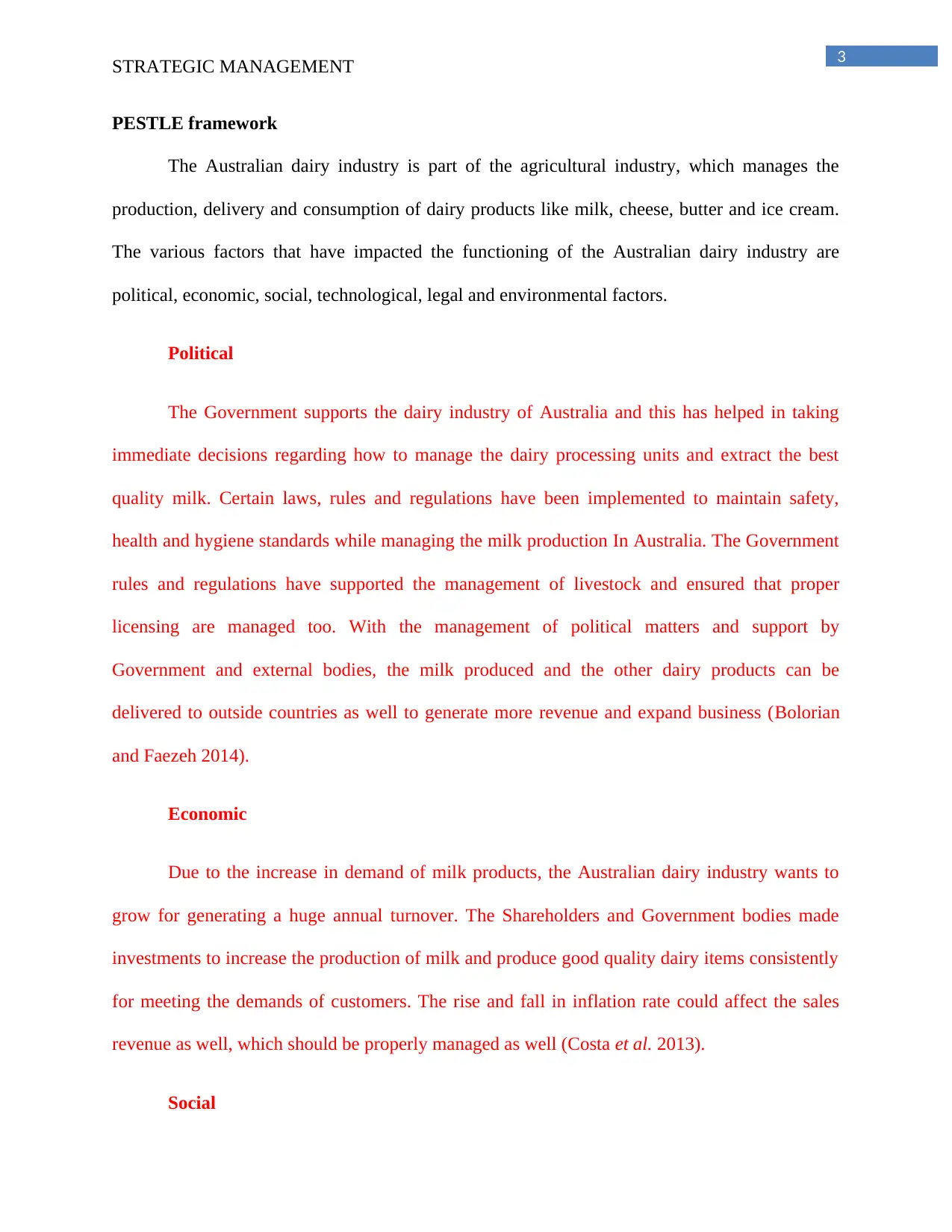
3
STRATEGIC MANAGEMENT
PESTLE framework
The Australian dairy industry is part of the agricultural industry, which manages the
production, delivery and consumption of dairy products like milk, cheese, butter and ice cream.
The various factors that have impacted the functioning of the Australian dairy industry are
political, economic, social, technological, legal and environmental factors.
Political
The Government supports the dairy industry of Australia and this has helped in taking
immediate decisions regarding how to manage the dairy processing units and extract the best
quality milk. Certain laws, rules and regulations have been implemented to maintain safety,
health and hygiene standards while managing the milk production In Australia. The Government
rules and regulations have supported the management of livestock and ensured that proper
licensing are managed too. With the management of political matters and support by
Government and external bodies, the milk produced and the other dairy products can be
delivered to outside countries as well to generate more revenue and expand business (Bolorian
and Faezeh 2014).
Economic
Due to the increase in demand of milk products, the Australian dairy industry wants to
grow for generating a huge annual turnover. The Shareholders and Government bodies made
investments to increase the production of milk and produce good quality dairy items consistently
for meeting the demands of customers. The rise and fall in inflation rate could affect the sales
revenue as well, which should be properly managed as well (Costa et al. 2013).
Social
STRATEGIC MANAGEMENT
PESTLE framework
The Australian dairy industry is part of the agricultural industry, which manages the
production, delivery and consumption of dairy products like milk, cheese, butter and ice cream.
The various factors that have impacted the functioning of the Australian dairy industry are
political, economic, social, technological, legal and environmental factors.
Political
The Government supports the dairy industry of Australia and this has helped in taking
immediate decisions regarding how to manage the dairy processing units and extract the best
quality milk. Certain laws, rules and regulations have been implemented to maintain safety,
health and hygiene standards while managing the milk production In Australia. The Government
rules and regulations have supported the management of livestock and ensured that proper
licensing are managed too. With the management of political matters and support by
Government and external bodies, the milk produced and the other dairy products can be
delivered to outside countries as well to generate more revenue and expand business (Bolorian
and Faezeh 2014).
Economic
Due to the increase in demand of milk products, the Australian dairy industry wants to
grow for generating a huge annual turnover. The Shareholders and Government bodies made
investments to increase the production of milk and produce good quality dairy items consistently
for meeting the demands of customers. The rise and fall in inflation rate could affect the sales
revenue as well, which should be properly managed as well (Costa et al. 2013).
Social
Secure Best Marks with AI Grader
Need help grading? Try our AI Grader for instant feedback on your assignments.
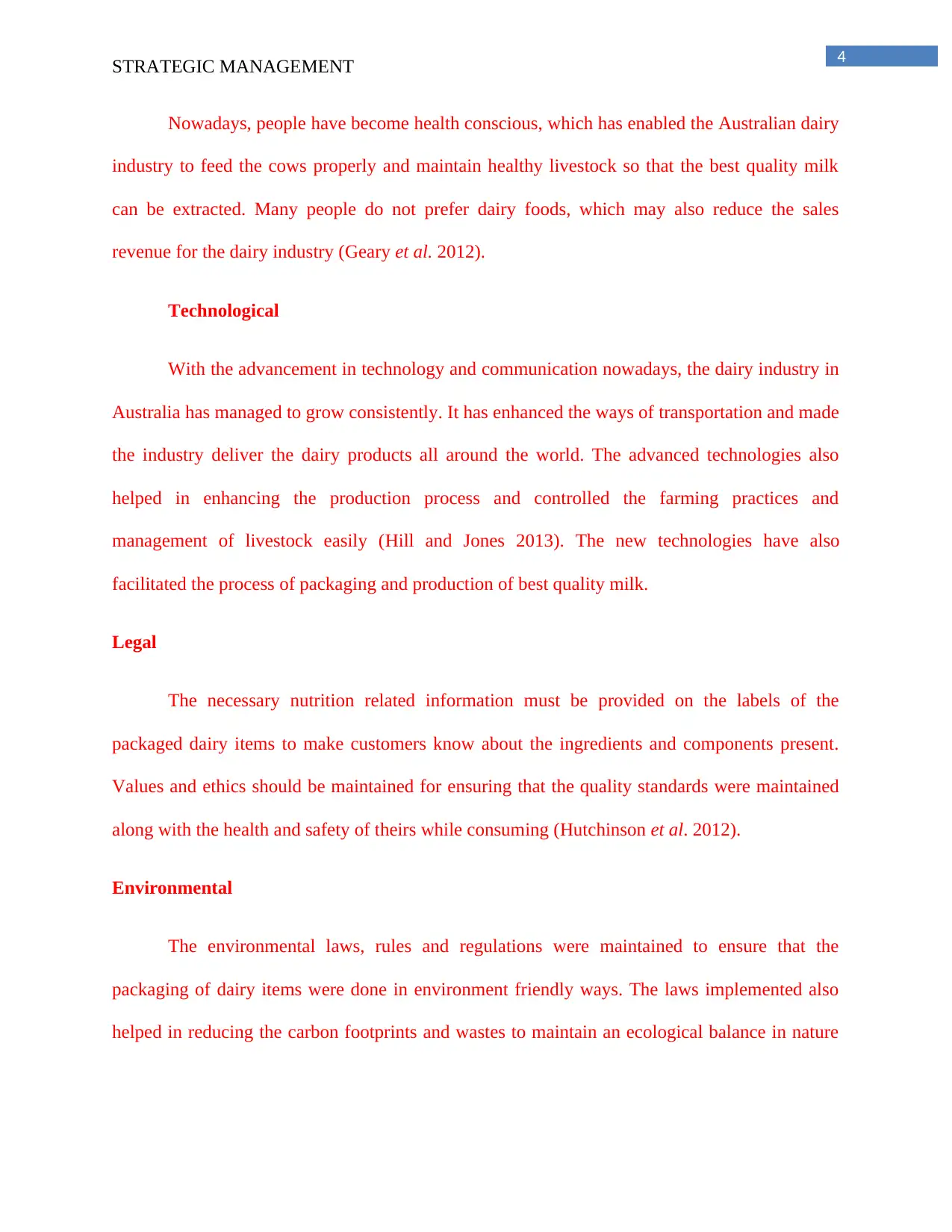
4
STRATEGIC MANAGEMENT
Nowadays, people have become health conscious, which has enabled the Australian dairy
industry to feed the cows properly and maintain healthy livestock so that the best quality milk
can be extracted. Many people do not prefer dairy foods, which may also reduce the sales
revenue for the dairy industry (Geary et al. 2012).
Technological
With the advancement in technology and communication nowadays, the dairy industry in
Australia has managed to grow consistently. It has enhanced the ways of transportation and made
the industry deliver the dairy products all around the world. The advanced technologies also
helped in enhancing the production process and controlled the farming practices and
management of livestock easily (Hill and Jones 2013). The new technologies have also
facilitated the process of packaging and production of best quality milk.
Legal
The necessary nutrition related information must be provided on the labels of the
packaged dairy items to make customers know about the ingredients and components present.
Values and ethics should be maintained for ensuring that the quality standards were maintained
along with the health and safety of theirs while consuming (Hutchinson et al. 2012).
Environmental
The environmental laws, rules and regulations were maintained to ensure that the
packaging of dairy items were done in environment friendly ways. The laws implemented also
helped in reducing the carbon footprints and wastes to maintain an ecological balance in nature
STRATEGIC MANAGEMENT
Nowadays, people have become health conscious, which has enabled the Australian dairy
industry to feed the cows properly and maintain healthy livestock so that the best quality milk
can be extracted. Many people do not prefer dairy foods, which may also reduce the sales
revenue for the dairy industry (Geary et al. 2012).
Technological
With the advancement in technology and communication nowadays, the dairy industry in
Australia has managed to grow consistently. It has enhanced the ways of transportation and made
the industry deliver the dairy products all around the world. The advanced technologies also
helped in enhancing the production process and controlled the farming practices and
management of livestock easily (Hill and Jones 2013). The new technologies have also
facilitated the process of packaging and production of best quality milk.
Legal
The necessary nutrition related information must be provided on the labels of the
packaged dairy items to make customers know about the ingredients and components present.
Values and ethics should be maintained for ensuring that the quality standards were maintained
along with the health and safety of theirs while consuming (Hutchinson et al. 2012).
Environmental
The environmental laws, rules and regulations were maintained to ensure that the
packaging of dairy items were done in environment friendly ways. The laws implemented also
helped in reducing the carbon footprints and wastes to maintain an ecological balance in nature

5
STRATEGIC MANAGEMENT
too, according to the Australian Government policies and practices (Jouzdani, Sadjadi and
Fathian 2013).
Five diamond theory
The Five-diamond theory has helped in analyzing the various components including the
arenas, vehicles, differentiators, staging and economic logic for the Australian Dairy industry
and how it has managed to compete with the New Zealand dairy industry.
Arenas
The arenas mean the areas where the Australian dairy industry should be active or want
to capture various market segments. The products mainly include dairy products such as milk
made items, butter, cheese, etc. and these are mainly supplied to the nearby locations and are
often exported to other country (Kumar and Prabhakar 2013). It is often termed as gold for the
export markets and so the emerging markets have been considered as major destinations of
dehydrated and UHT milk produced by the dairy industry.
Vehicles
As the name suggests, it is some kind of transportation activities that are managed for
marketing the products and make sure that the products are delivered to the customers properly.
The vehicles and transportation through air, water and land have been made possible for making
sure that the products are delivered to the right places. There are joint ventures too, which has
helped in working in partnership and ensure expansion of business. The mergers and acquisition
of other companies within the Australian dairy industry have also brought good outcomes.
Differentiators
STRATEGIC MANAGEMENT
too, according to the Australian Government policies and practices (Jouzdani, Sadjadi and
Fathian 2013).
Five diamond theory
The Five-diamond theory has helped in analyzing the various components including the
arenas, vehicles, differentiators, staging and economic logic for the Australian Dairy industry
and how it has managed to compete with the New Zealand dairy industry.
Arenas
The arenas mean the areas where the Australian dairy industry should be active or want
to capture various market segments. The products mainly include dairy products such as milk
made items, butter, cheese, etc. and these are mainly supplied to the nearby locations and are
often exported to other country (Kumar and Prabhakar 2013). It is often termed as gold for the
export markets and so the emerging markets have been considered as major destinations of
dehydrated and UHT milk produced by the dairy industry.
Vehicles
As the name suggests, it is some kind of transportation activities that are managed for
marketing the products and make sure that the products are delivered to the customers properly.
The vehicles and transportation through air, water and land have been made possible for making
sure that the products are delivered to the right places. There are joint ventures too, which has
helped in working in partnership and ensure expansion of business. The mergers and acquisition
of other companies within the Australian dairy industry have also brought good outcomes.
Differentiators
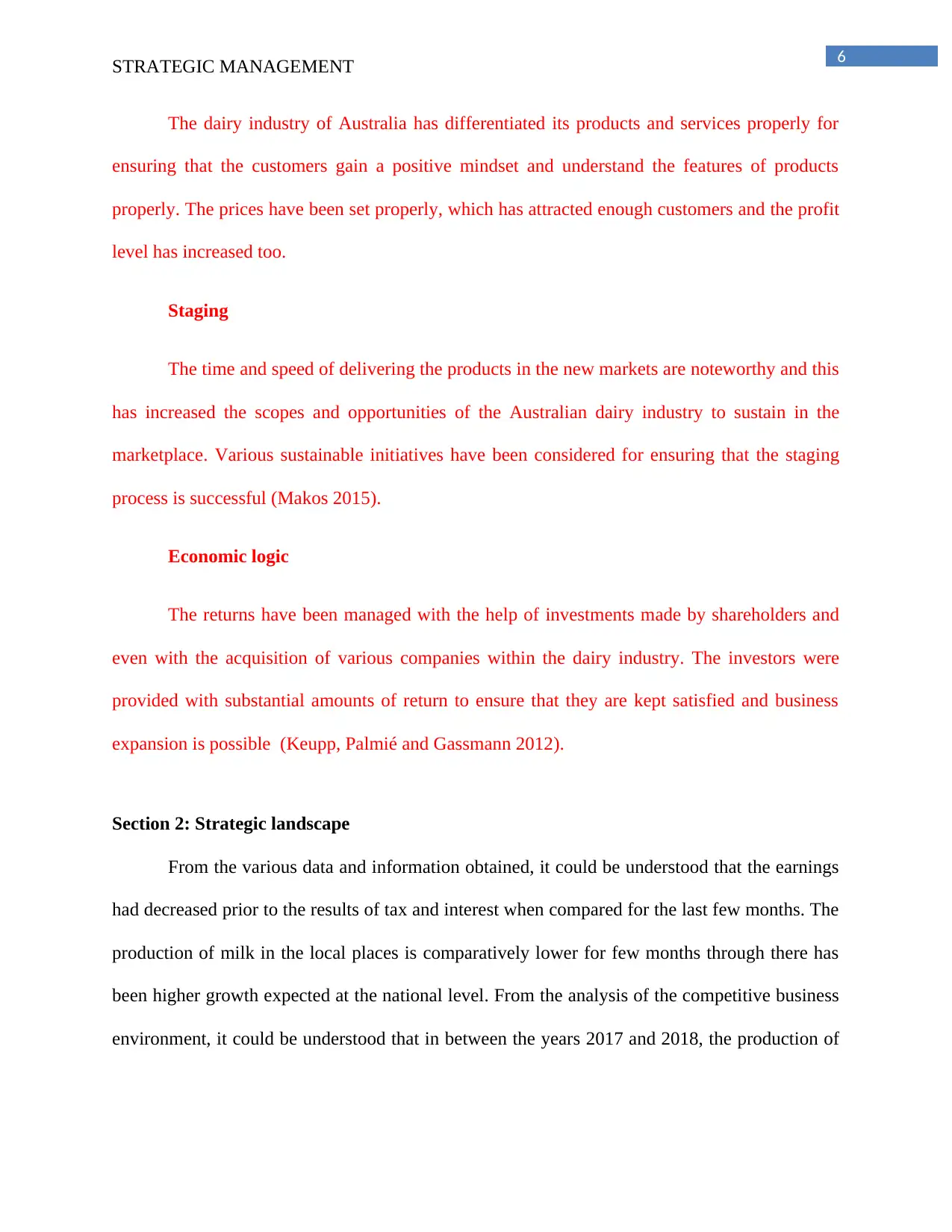
6
STRATEGIC MANAGEMENT
The dairy industry of Australia has differentiated its products and services properly for
ensuring that the customers gain a positive mindset and understand the features of products
properly. The prices have been set properly, which has attracted enough customers and the profit
level has increased too.
Staging
The time and speed of delivering the products in the new markets are noteworthy and this
has increased the scopes and opportunities of the Australian dairy industry to sustain in the
marketplace. Various sustainable initiatives have been considered for ensuring that the staging
process is successful (Makos 2015).
Economic logic
The returns have been managed with the help of investments made by shareholders and
even with the acquisition of various companies within the dairy industry. The investors were
provided with substantial amounts of return to ensure that they are kept satisfied and business
expansion is possible (Keupp, Palmié and Gassmann 2012).
Section 2: Strategic landscape
From the various data and information obtained, it could be understood that the earnings
had decreased prior to the results of tax and interest when compared for the last few months. The
production of milk in the local places is comparatively lower for few months through there has
been higher growth expected at the national level. From the analysis of the competitive business
environment, it could be understood that in between the years 2017 and 2018, the production of
STRATEGIC MANAGEMENT
The dairy industry of Australia has differentiated its products and services properly for
ensuring that the customers gain a positive mindset and understand the features of products
properly. The prices have been set properly, which has attracted enough customers and the profit
level has increased too.
Staging
The time and speed of delivering the products in the new markets are noteworthy and this
has increased the scopes and opportunities of the Australian dairy industry to sustain in the
marketplace. Various sustainable initiatives have been considered for ensuring that the staging
process is successful (Makos 2015).
Economic logic
The returns have been managed with the help of investments made by shareholders and
even with the acquisition of various companies within the dairy industry. The investors were
provided with substantial amounts of return to ensure that they are kept satisfied and business
expansion is possible (Keupp, Palmié and Gassmann 2012).
Section 2: Strategic landscape
From the various data and information obtained, it could be understood that the earnings
had decreased prior to the results of tax and interest when compared for the last few months. The
production of milk in the local places is comparatively lower for few months through there has
been higher growth expected at the national level. From the analysis of the competitive business
environment, it could be understood that in between the years 2017 and 2018, the production of
Paraphrase This Document
Need a fresh take? Get an instant paraphrase of this document with our AI Paraphraser
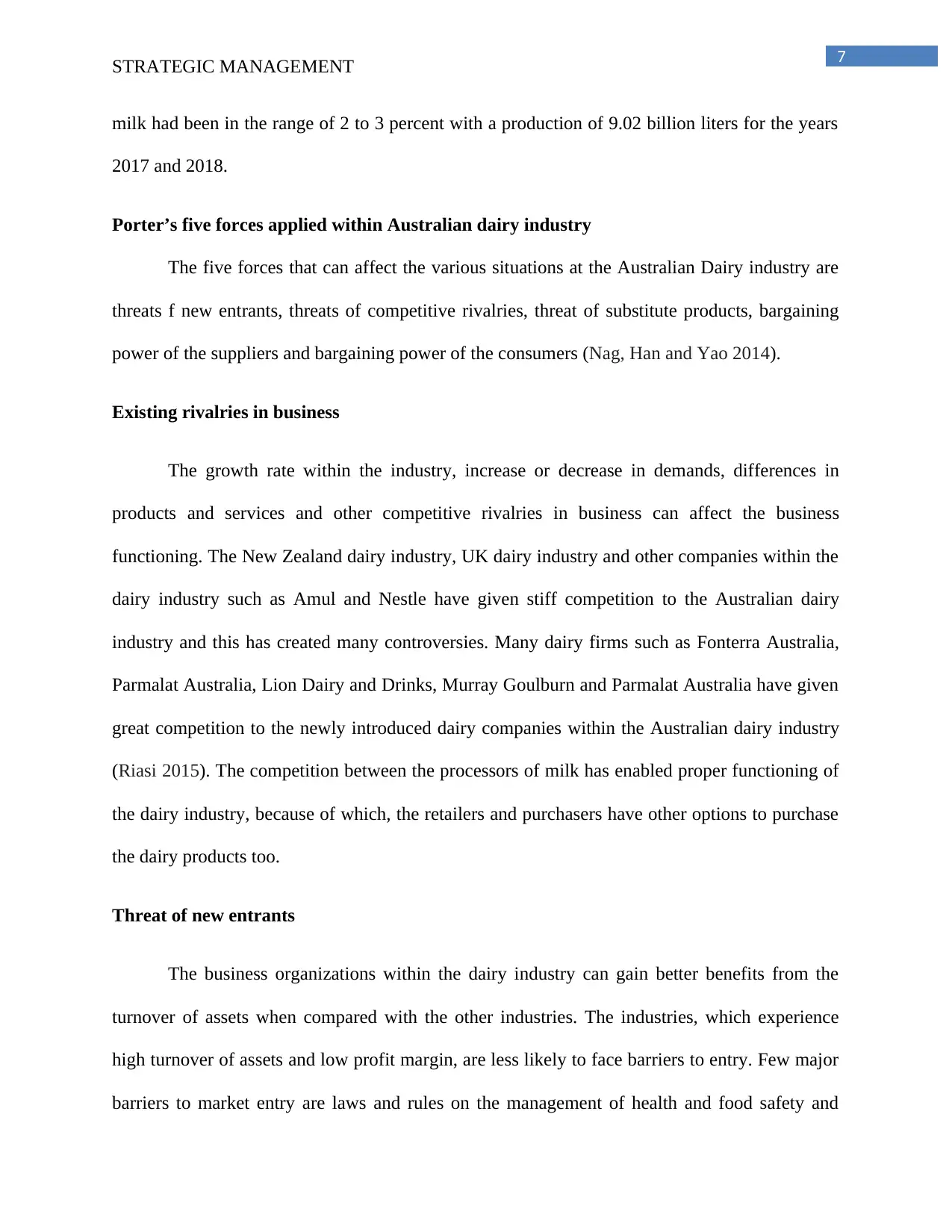
7
STRATEGIC MANAGEMENT
milk had been in the range of 2 to 3 percent with a production of 9.02 billion liters for the years
2017 and 2018.
Porter’s five forces applied within Australian dairy industry
The five forces that can affect the various situations at the Australian Dairy industry are
threats f new entrants, threats of competitive rivalries, threat of substitute products, bargaining
power of the suppliers and bargaining power of the consumers (Nag, Han and Yao 2014).
Existing rivalries in business
The growth rate within the industry, increase or decrease in demands, differences in
products and services and other competitive rivalries in business can affect the business
functioning. The New Zealand dairy industry, UK dairy industry and other companies within the
dairy industry such as Amul and Nestle have given stiff competition to the Australian dairy
industry and this has created many controversies. Many dairy firms such as Fonterra Australia,
Parmalat Australia, Lion Dairy and Drinks, Murray Goulburn and Parmalat Australia have given
great competition to the newly introduced dairy companies within the Australian dairy industry
(Riasi 2015). The competition between the processors of milk has enabled proper functioning of
the dairy industry, because of which, the retailers and purchasers have other options to purchase
the dairy products too.
Threat of new entrants
The business organizations within the dairy industry can gain better benefits from the
turnover of assets when compared with the other industries. The industries, which experience
high turnover of assets and low profit margin, are less likely to face barriers to entry. Few major
barriers to market entry are laws and rules on the management of health and food safety and
STRATEGIC MANAGEMENT
milk had been in the range of 2 to 3 percent with a production of 9.02 billion liters for the years
2017 and 2018.
Porter’s five forces applied within Australian dairy industry
The five forces that can affect the various situations at the Australian Dairy industry are
threats f new entrants, threats of competitive rivalries, threat of substitute products, bargaining
power of the suppliers and bargaining power of the consumers (Nag, Han and Yao 2014).
Existing rivalries in business
The growth rate within the industry, increase or decrease in demands, differences in
products and services and other competitive rivalries in business can affect the business
functioning. The New Zealand dairy industry, UK dairy industry and other companies within the
dairy industry such as Amul and Nestle have given stiff competition to the Australian dairy
industry and this has created many controversies. Many dairy firms such as Fonterra Australia,
Parmalat Australia, Lion Dairy and Drinks, Murray Goulburn and Parmalat Australia have given
great competition to the newly introduced dairy companies within the Australian dairy industry
(Riasi 2015). The competition between the processors of milk has enabled proper functioning of
the dairy industry, because of which, the retailers and purchasers have other options to purchase
the dairy products too.
Threat of new entrants
The business organizations within the dairy industry can gain better benefits from the
turnover of assets when compared with the other industries. The industries, which experience
high turnover of assets and low profit margin, are less likely to face barriers to entry. Few major
barriers to market entry are laws and rules on the management of health and food safety and
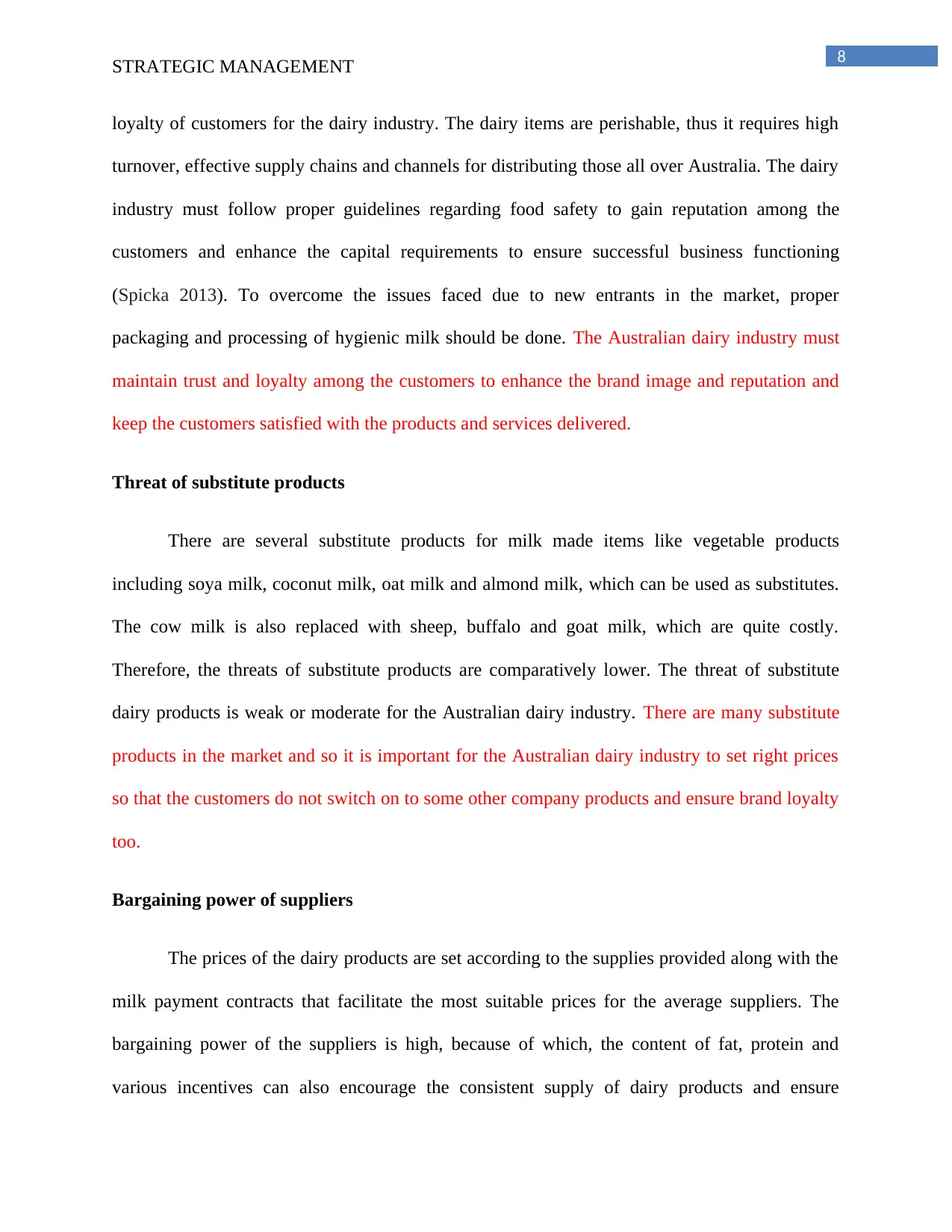
8
STRATEGIC MANAGEMENT
loyalty of customers for the dairy industry. The dairy items are perishable, thus it requires high
turnover, effective supply chains and channels for distributing those all over Australia. The dairy
industry must follow proper guidelines regarding food safety to gain reputation among the
customers and enhance the capital requirements to ensure successful business functioning
(Spicka 2013). To overcome the issues faced due to new entrants in the market, proper
packaging and processing of hygienic milk should be done. The Australian dairy industry must
maintain trust and loyalty among the customers to enhance the brand image and reputation and
keep the customers satisfied with the products and services delivered.
Threat of substitute products
There are several substitute products for milk made items like vegetable products
including soya milk, coconut milk, oat milk and almond milk, which can be used as substitutes.
The cow milk is also replaced with sheep, buffalo and goat milk, which are quite costly.
Therefore, the threats of substitute products are comparatively lower. The threat of substitute
dairy products is weak or moderate for the Australian dairy industry. There are many substitute
products in the market and so it is important for the Australian dairy industry to set right prices
so that the customers do not switch on to some other company products and ensure brand loyalty
too.
Bargaining power of suppliers
The prices of the dairy products are set according to the supplies provided along with the
milk payment contracts that facilitate the most suitable prices for the average suppliers. The
bargaining power of the suppliers is high, because of which, the content of fat, protein and
various incentives can also encourage the consistent supply of dairy products and ensure
STRATEGIC MANAGEMENT
loyalty of customers for the dairy industry. The dairy items are perishable, thus it requires high
turnover, effective supply chains and channels for distributing those all over Australia. The dairy
industry must follow proper guidelines regarding food safety to gain reputation among the
customers and enhance the capital requirements to ensure successful business functioning
(Spicka 2013). To overcome the issues faced due to new entrants in the market, proper
packaging and processing of hygienic milk should be done. The Australian dairy industry must
maintain trust and loyalty among the customers to enhance the brand image and reputation and
keep the customers satisfied with the products and services delivered.
Threat of substitute products
There are several substitute products for milk made items like vegetable products
including soya milk, coconut milk, oat milk and almond milk, which can be used as substitutes.
The cow milk is also replaced with sheep, buffalo and goat milk, which are quite costly.
Therefore, the threats of substitute products are comparatively lower. The threat of substitute
dairy products is weak or moderate for the Australian dairy industry. There are many substitute
products in the market and so it is important for the Australian dairy industry to set right prices
so that the customers do not switch on to some other company products and ensure brand loyalty
too.
Bargaining power of suppliers
The prices of the dairy products are set according to the supplies provided along with the
milk payment contracts that facilitate the most suitable prices for the average suppliers. The
bargaining power of the suppliers is high, because of which, the content of fat, protein and
various incentives can also encourage the consistent supply of dairy products and ensure
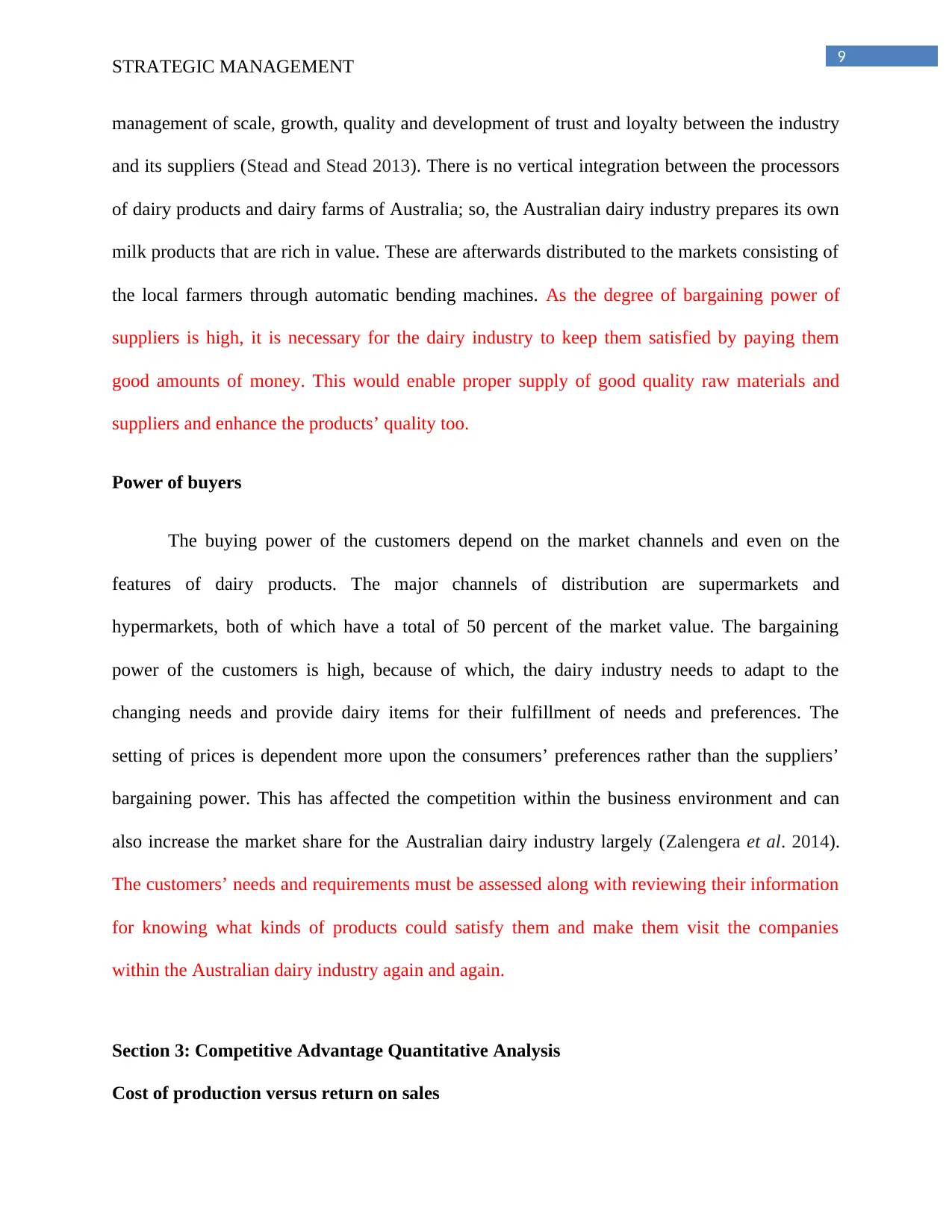
9
STRATEGIC MANAGEMENT
management of scale, growth, quality and development of trust and loyalty between the industry
and its suppliers (Stead and Stead 2013). There is no vertical integration between the processors
of dairy products and dairy farms of Australia; so, the Australian dairy industry prepares its own
milk products that are rich in value. These are afterwards distributed to the markets consisting of
the local farmers through automatic bending machines. As the degree of bargaining power of
suppliers is high, it is necessary for the dairy industry to keep them satisfied by paying them
good amounts of money. This would enable proper supply of good quality raw materials and
suppliers and enhance the products’ quality too.
Power of buyers
The buying power of the customers depend on the market channels and even on the
features of dairy products. The major channels of distribution are supermarkets and
hypermarkets, both of which have a total of 50 percent of the market value. The bargaining
power of the customers is high, because of which, the dairy industry needs to adapt to the
changing needs and provide dairy items for their fulfillment of needs and preferences. The
setting of prices is dependent more upon the consumers’ preferences rather than the suppliers’
bargaining power. This has affected the competition within the business environment and can
also increase the market share for the Australian dairy industry largely (Zalengera et al. 2014).
The customers’ needs and requirements must be assessed along with reviewing their information
for knowing what kinds of products could satisfy them and make them visit the companies
within the Australian dairy industry again and again.
Section 3: Competitive Advantage Quantitative Analysis
Cost of production versus return on sales
STRATEGIC MANAGEMENT
management of scale, growth, quality and development of trust and loyalty between the industry
and its suppliers (Stead and Stead 2013). There is no vertical integration between the processors
of dairy products and dairy farms of Australia; so, the Australian dairy industry prepares its own
milk products that are rich in value. These are afterwards distributed to the markets consisting of
the local farmers through automatic bending machines. As the degree of bargaining power of
suppliers is high, it is necessary for the dairy industry to keep them satisfied by paying them
good amounts of money. This would enable proper supply of good quality raw materials and
suppliers and enhance the products’ quality too.
Power of buyers
The buying power of the customers depend on the market channels and even on the
features of dairy products. The major channels of distribution are supermarkets and
hypermarkets, both of which have a total of 50 percent of the market value. The bargaining
power of the customers is high, because of which, the dairy industry needs to adapt to the
changing needs and provide dairy items for their fulfillment of needs and preferences. The
setting of prices is dependent more upon the consumers’ preferences rather than the suppliers’
bargaining power. This has affected the competition within the business environment and can
also increase the market share for the Australian dairy industry largely (Zalengera et al. 2014).
The customers’ needs and requirements must be assessed along with reviewing their information
for knowing what kinds of products could satisfy them and make them visit the companies
within the Australian dairy industry again and again.
Section 3: Competitive Advantage Quantitative Analysis
Cost of production versus return on sales
Secure Best Marks with AI Grader
Need help grading? Try our AI Grader for instant feedback on your assignments.
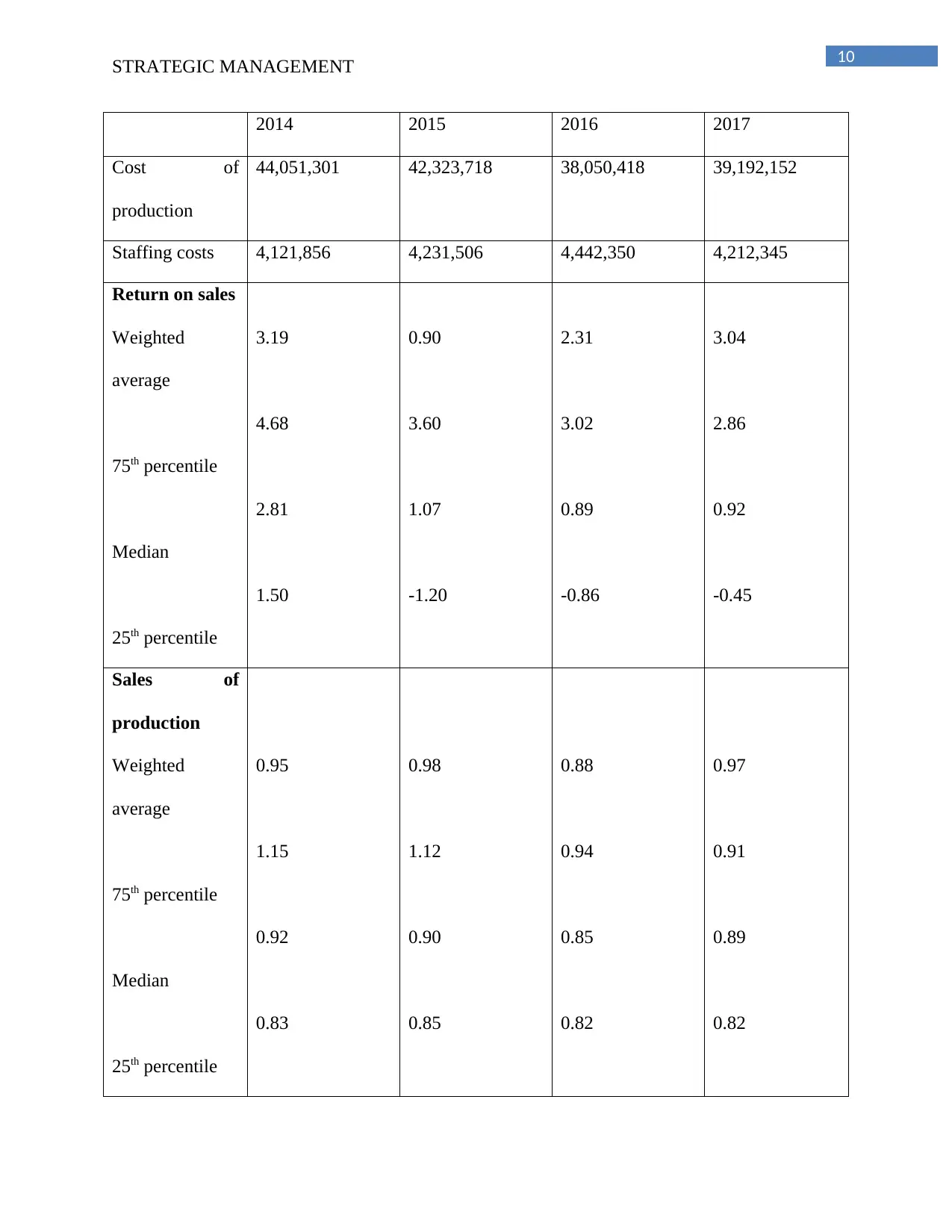
10
STRATEGIC MANAGEMENT
2014 2015 2016 2017
Cost of
production
44,051,301 42,323,718 38,050,418 39,192,152
Staffing costs 4,121,856 4,231,506 4,442,350 4,212,345
Return on sales
Weighted
average
75th percentile
Median
25th percentile
3.19
4.68
2.81
1.50
0.90
3.60
1.07
-1.20
2.31
3.02
0.89
-0.86
3.04
2.86
0.92
-0.45
Sales of
production
Weighted
average
75th percentile
Median
25th percentile
0.95
1.15
0.92
0.83
0.98
1.12
0.90
0.85
0.88
0.94
0.85
0.82
0.97
0.91
0.89
0.82
STRATEGIC MANAGEMENT
2014 2015 2016 2017
Cost of
production
44,051,301 42,323,718 38,050,418 39,192,152
Staffing costs 4,121,856 4,231,506 4,442,350 4,212,345
Return on sales
Weighted
average
75th percentile
Median
25th percentile
3.19
4.68
2.81
1.50
0.90
3.60
1.07
-1.20
2.31
3.02
0.89
-0.86
3.04
2.86
0.92
-0.45
Sales of
production
Weighted
average
75th percentile
Median
25th percentile
0.95
1.15
0.92
0.83
0.98
1.12
0.90
0.85
0.88
0.94
0.85
0.82
0.97
0.91
0.89
0.82
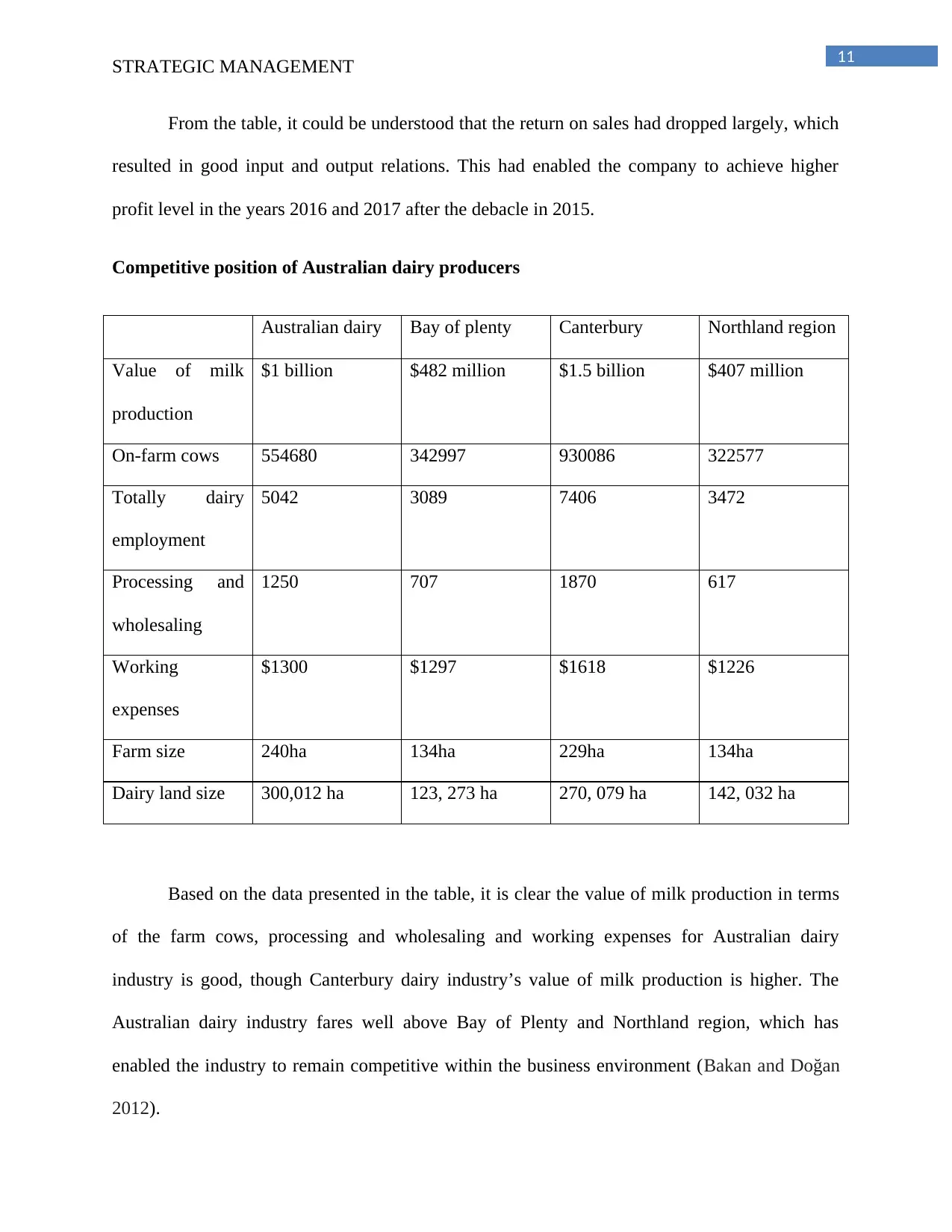
11
STRATEGIC MANAGEMENT
From the table, it could be understood that the return on sales had dropped largely, which
resulted in good input and output relations. This had enabled the company to achieve higher
profit level in the years 2016 and 2017 after the debacle in 2015.
Competitive position of Australian dairy producers
Australian dairy Bay of plenty Canterbury Northland region
Value of milk
production
$1 billion $482 million $1.5 billion $407 million
On-farm cows 554680 342997 930086 322577
Totally dairy
employment
5042 3089 7406 3472
Processing and
wholesaling
1250 707 1870 617
Working
expenses
$1300 $1297 $1618 $1226
Farm size 240ha 134ha 229ha 134ha
Dairy land size 300,012 ha 123, 273 ha 270, 079 ha 142, 032 ha
Based on the data presented in the table, it is clear the value of milk production in terms
of the farm cows, processing and wholesaling and working expenses for Australian dairy
industry is good, though Canterbury dairy industry’s value of milk production is higher. The
Australian dairy industry fares well above Bay of Plenty and Northland region, which has
enabled the industry to remain competitive within the business environment (Bakan and Doğan
2012).
STRATEGIC MANAGEMENT
From the table, it could be understood that the return on sales had dropped largely, which
resulted in good input and output relations. This had enabled the company to achieve higher
profit level in the years 2016 and 2017 after the debacle in 2015.
Competitive position of Australian dairy producers
Australian dairy Bay of plenty Canterbury Northland region
Value of milk
production
$1 billion $482 million $1.5 billion $407 million
On-farm cows 554680 342997 930086 322577
Totally dairy
employment
5042 3089 7406 3472
Processing and
wholesaling
1250 707 1870 617
Working
expenses
$1300 $1297 $1618 $1226
Farm size 240ha 134ha 229ha 134ha
Dairy land size 300,012 ha 123, 273 ha 270, 079 ha 142, 032 ha
Based on the data presented in the table, it is clear the value of milk production in terms
of the farm cows, processing and wholesaling and working expenses for Australian dairy
industry is good, though Canterbury dairy industry’s value of milk production is higher. The
Australian dairy industry fares well above Bay of Plenty and Northland region, which has
enabled the industry to remain competitive within the business environment (Bakan and Doğan
2012).
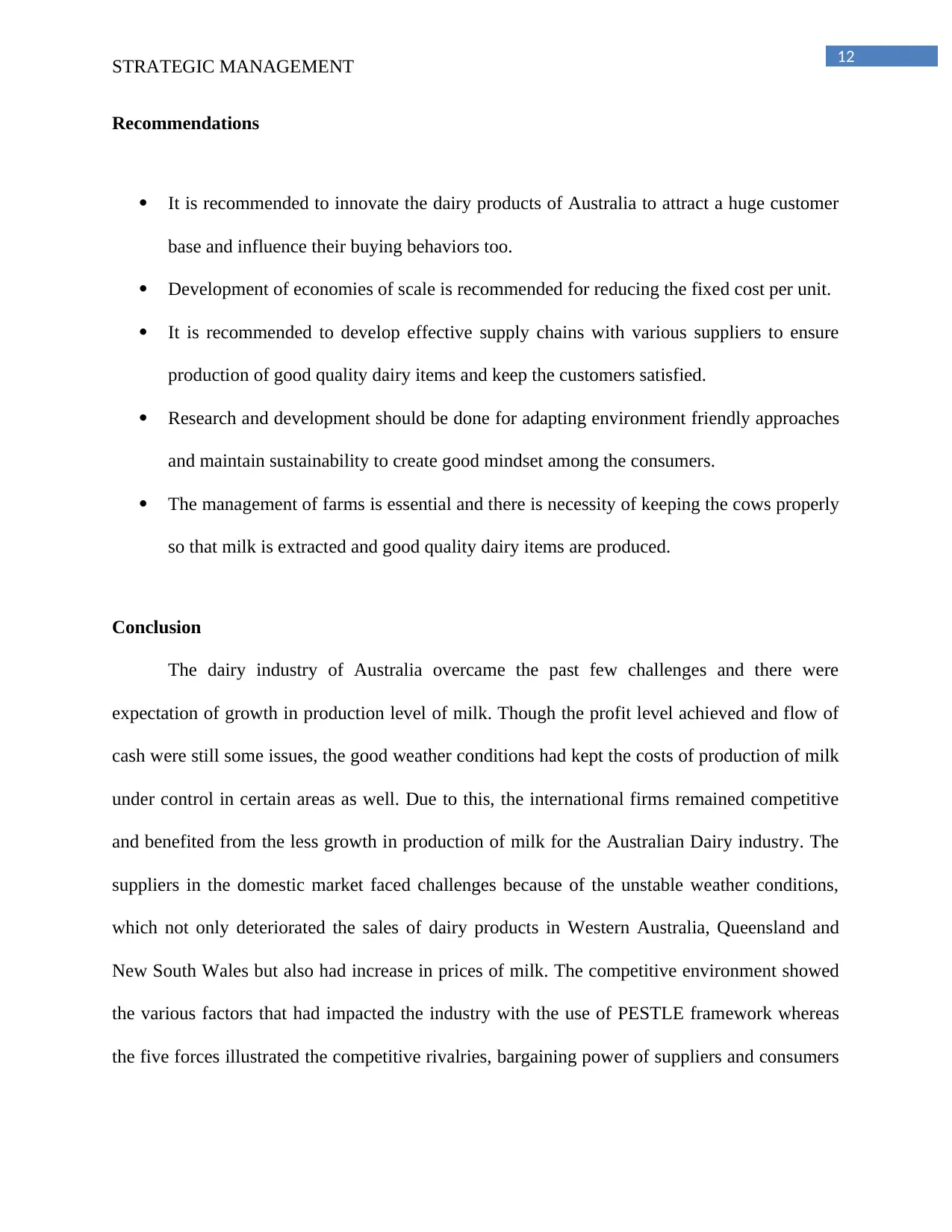
12
STRATEGIC MANAGEMENT
Recommendations
It is recommended to innovate the dairy products of Australia to attract a huge customer
base and influence their buying behaviors too.
Development of economies of scale is recommended for reducing the fixed cost per unit.
It is recommended to develop effective supply chains with various suppliers to ensure
production of good quality dairy items and keep the customers satisfied.
Research and development should be done for adapting environment friendly approaches
and maintain sustainability to create good mindset among the consumers.
The management of farms is essential and there is necessity of keeping the cows properly
so that milk is extracted and good quality dairy items are produced.
Conclusion
The dairy industry of Australia overcame the past few challenges and there were
expectation of growth in production level of milk. Though the profit level achieved and flow of
cash were still some issues, the good weather conditions had kept the costs of production of milk
under control in certain areas as well. Due to this, the international firms remained competitive
and benefited from the less growth in production of milk for the Australian Dairy industry. The
suppliers in the domestic market faced challenges because of the unstable weather conditions,
which not only deteriorated the sales of dairy products in Western Australia, Queensland and
New South Wales but also had increase in prices of milk. The competitive environment showed
the various factors that had impacted the industry with the use of PESTLE framework whereas
the five forces illustrated the competitive rivalries, bargaining power of suppliers and consumers
STRATEGIC MANAGEMENT
Recommendations
It is recommended to innovate the dairy products of Australia to attract a huge customer
base and influence their buying behaviors too.
Development of economies of scale is recommended for reducing the fixed cost per unit.
It is recommended to develop effective supply chains with various suppliers to ensure
production of good quality dairy items and keep the customers satisfied.
Research and development should be done for adapting environment friendly approaches
and maintain sustainability to create good mindset among the consumers.
The management of farms is essential and there is necessity of keeping the cows properly
so that milk is extracted and good quality dairy items are produced.
Conclusion
The dairy industry of Australia overcame the past few challenges and there were
expectation of growth in production level of milk. Though the profit level achieved and flow of
cash were still some issues, the good weather conditions had kept the costs of production of milk
under control in certain areas as well. Due to this, the international firms remained competitive
and benefited from the less growth in production of milk for the Australian Dairy industry. The
suppliers in the domestic market faced challenges because of the unstable weather conditions,
which not only deteriorated the sales of dairy products in Western Australia, Queensland and
New South Wales but also had increase in prices of milk. The competitive environment showed
the various factors that had impacted the industry with the use of PESTLE framework whereas
the five forces illustrated the competitive rivalries, bargaining power of suppliers and consumers
Paraphrase This Document
Need a fresh take? Get an instant paraphrase of this document with our AI Paraphraser
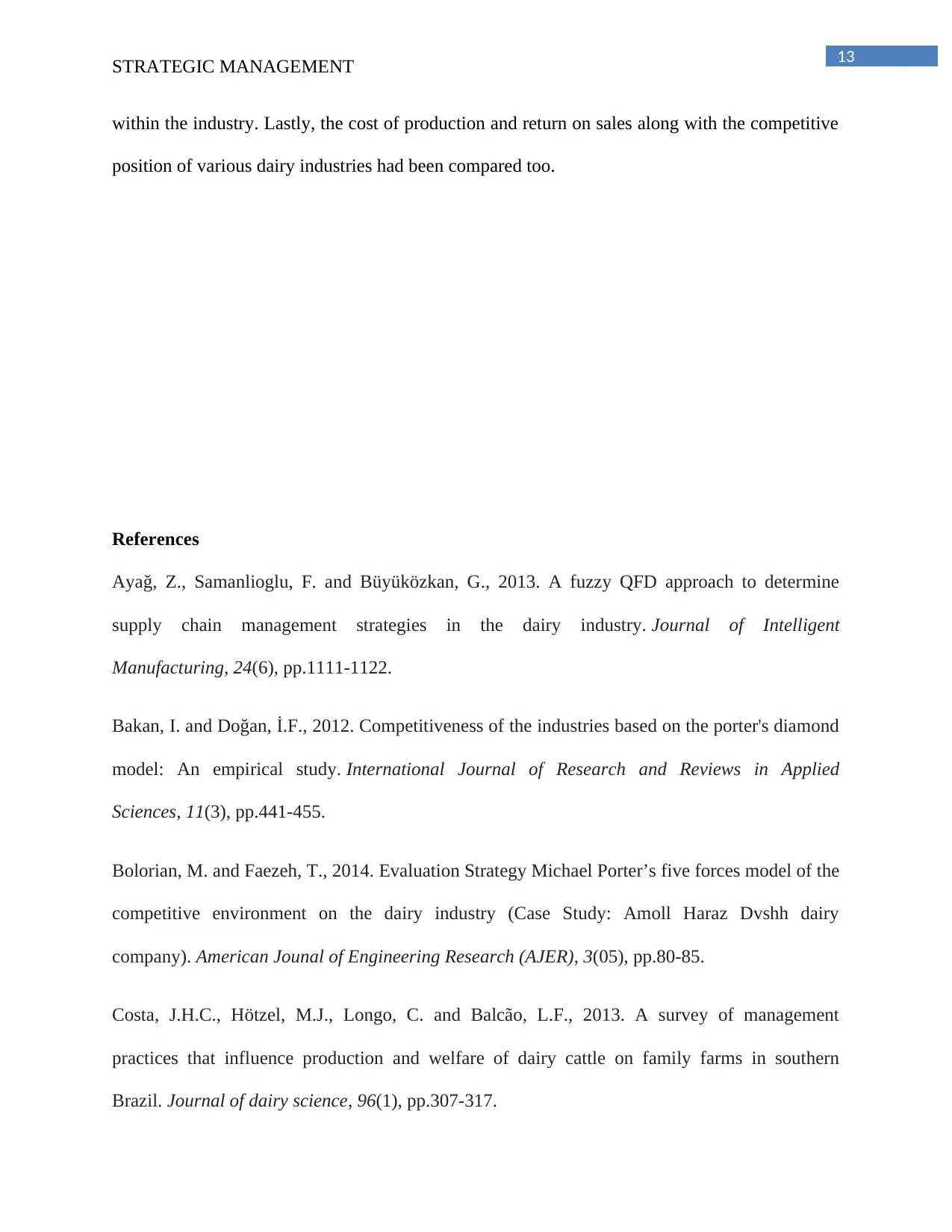
13
STRATEGIC MANAGEMENT
within the industry. Lastly, the cost of production and return on sales along with the competitive
position of various dairy industries had been compared too.
References
Ayağ, Z., Samanlioglu, F. and Büyüközkan, G., 2013. A fuzzy QFD approach to determine
supply chain management strategies in the dairy industry. Journal of Intelligent
Manufacturing, 24(6), pp.1111-1122.
Bakan, I. and Doğan, İ.F., 2012. Competitiveness of the industries based on the porter's diamond
model: An empirical study. International Journal of Research and Reviews in Applied
Sciences, 11(3), pp.441-455.
Bolorian, M. and Faezeh, T., 2014. Evaluation Strategy Michael Porter’s five forces model of the
competitive environment on the dairy industry (Case Study: Amoll Haraz Dvshh dairy
company). American Jounal of Engineering Research (AJER), 3(05), pp.80-85.
Costa, J.H.C., Hötzel, M.J., Longo, C. and Balcão, L.F., 2013. A survey of management
practices that influence production and welfare of dairy cattle on family farms in southern
Brazil. Journal of dairy science, 96(1), pp.307-317.
STRATEGIC MANAGEMENT
within the industry. Lastly, the cost of production and return on sales along with the competitive
position of various dairy industries had been compared too.
References
Ayağ, Z., Samanlioglu, F. and Büyüközkan, G., 2013. A fuzzy QFD approach to determine
supply chain management strategies in the dairy industry. Journal of Intelligent
Manufacturing, 24(6), pp.1111-1122.
Bakan, I. and Doğan, İ.F., 2012. Competitiveness of the industries based on the porter's diamond
model: An empirical study. International Journal of Research and Reviews in Applied
Sciences, 11(3), pp.441-455.
Bolorian, M. and Faezeh, T., 2014. Evaluation Strategy Michael Porter’s five forces model of the
competitive environment on the dairy industry (Case Study: Amoll Haraz Dvshh dairy
company). American Jounal of Engineering Research (AJER), 3(05), pp.80-85.
Costa, J.H.C., Hötzel, M.J., Longo, C. and Balcão, L.F., 2013. A survey of management
practices that influence production and welfare of dairy cattle on family farms in southern
Brazil. Journal of dairy science, 96(1), pp.307-317.
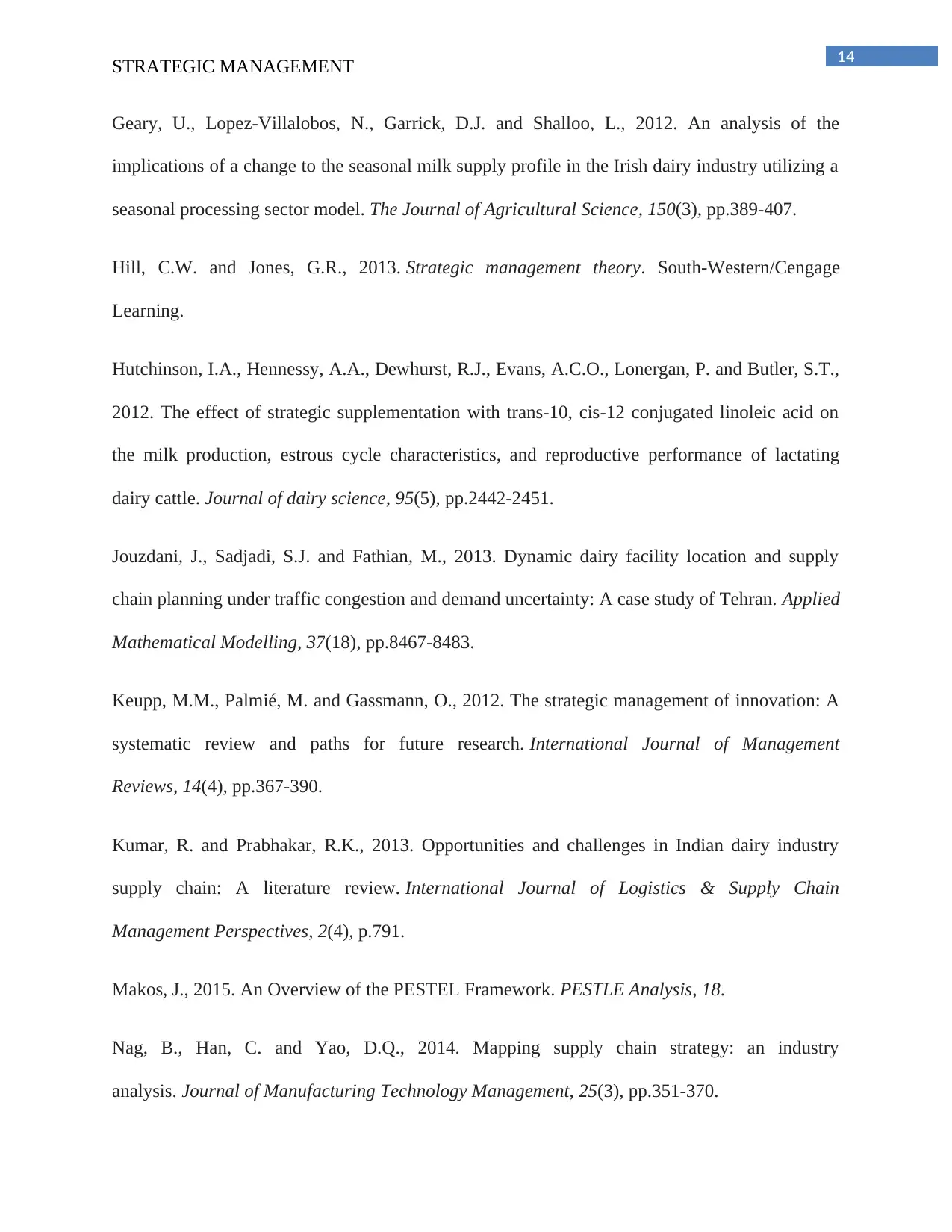
14
STRATEGIC MANAGEMENT
Geary, U., Lopez-Villalobos, N., Garrick, D.J. and Shalloo, L., 2012. An analysis of the
implications of a change to the seasonal milk supply profile in the Irish dairy industry utilizing a
seasonal processing sector model. The Journal of Agricultural Science, 150(3), pp.389-407.
Hill, C.W. and Jones, G.R., 2013. Strategic management theory. South-Western/Cengage
Learning.
Hutchinson, I.A., Hennessy, A.A., Dewhurst, R.J., Evans, A.C.O., Lonergan, P. and Butler, S.T.,
2012. The effect of strategic supplementation with trans-10, cis-12 conjugated linoleic acid on
the milk production, estrous cycle characteristics, and reproductive performance of lactating
dairy cattle. Journal of dairy science, 95(5), pp.2442-2451.
Jouzdani, J., Sadjadi, S.J. and Fathian, M., 2013. Dynamic dairy facility location and supply
chain planning under traffic congestion and demand uncertainty: A case study of Tehran. Applied
Mathematical Modelling, 37(18), pp.8467-8483.
Keupp, M.M., Palmié, M. and Gassmann, O., 2012. The strategic management of innovation: A
systematic review and paths for future research. International Journal of Management
Reviews, 14(4), pp.367-390.
Kumar, R. and Prabhakar, R.K., 2013. Opportunities and challenges in Indian dairy industry
supply chain: A literature review. International Journal of Logistics & Supply Chain
Management Perspectives, 2(4), p.791.
Makos, J., 2015. An Overview of the PESTEL Framework. PESTLE Analysis, 18.
Nag, B., Han, C. and Yao, D.Q., 2014. Mapping supply chain strategy: an industry
analysis. Journal of Manufacturing Technology Management, 25(3), pp.351-370.
STRATEGIC MANAGEMENT
Geary, U., Lopez-Villalobos, N., Garrick, D.J. and Shalloo, L., 2012. An analysis of the
implications of a change to the seasonal milk supply profile in the Irish dairy industry utilizing a
seasonal processing sector model. The Journal of Agricultural Science, 150(3), pp.389-407.
Hill, C.W. and Jones, G.R., 2013. Strategic management theory. South-Western/Cengage
Learning.
Hutchinson, I.A., Hennessy, A.A., Dewhurst, R.J., Evans, A.C.O., Lonergan, P. and Butler, S.T.,
2012. The effect of strategic supplementation with trans-10, cis-12 conjugated linoleic acid on
the milk production, estrous cycle characteristics, and reproductive performance of lactating
dairy cattle. Journal of dairy science, 95(5), pp.2442-2451.
Jouzdani, J., Sadjadi, S.J. and Fathian, M., 2013. Dynamic dairy facility location and supply
chain planning under traffic congestion and demand uncertainty: A case study of Tehran. Applied
Mathematical Modelling, 37(18), pp.8467-8483.
Keupp, M.M., Palmié, M. and Gassmann, O., 2012. The strategic management of innovation: A
systematic review and paths for future research. International Journal of Management
Reviews, 14(4), pp.367-390.
Kumar, R. and Prabhakar, R.K., 2013. Opportunities and challenges in Indian dairy industry
supply chain: A literature review. International Journal of Logistics & Supply Chain
Management Perspectives, 2(4), p.791.
Makos, J., 2015. An Overview of the PESTEL Framework. PESTLE Analysis, 18.
Nag, B., Han, C. and Yao, D.Q., 2014. Mapping supply chain strategy: an industry
analysis. Journal of Manufacturing Technology Management, 25(3), pp.351-370.
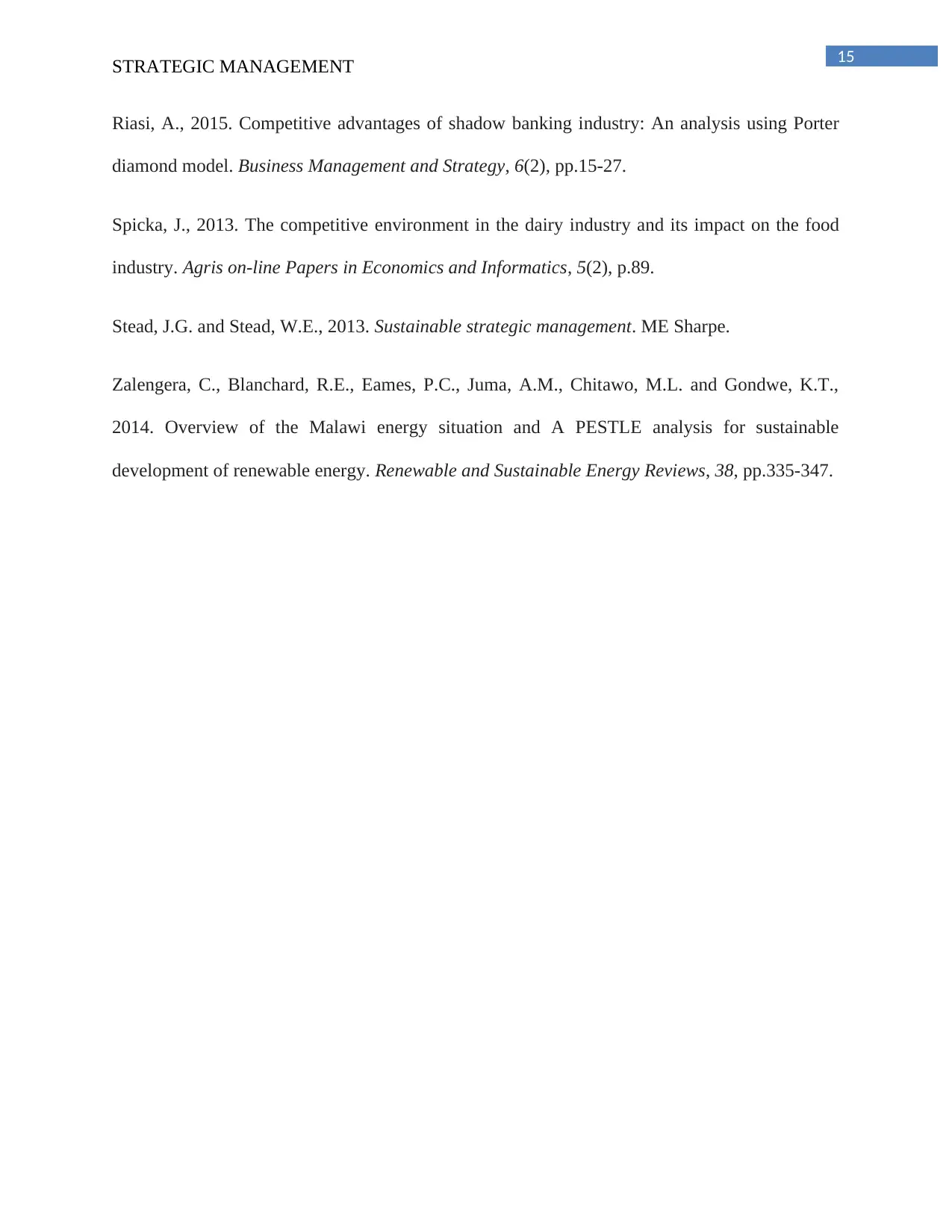
15
STRATEGIC MANAGEMENT
Riasi, A., 2015. Competitive advantages of shadow banking industry: An analysis using Porter
diamond model. Business Management and Strategy, 6(2), pp.15-27.
Spicka, J., 2013. The competitive environment in the dairy industry and its impact on the food
industry. Agris on-line Papers in Economics and Informatics, 5(2), p.89.
Stead, J.G. and Stead, W.E., 2013. Sustainable strategic management. ME Sharpe.
Zalengera, C., Blanchard, R.E., Eames, P.C., Juma, A.M., Chitawo, M.L. and Gondwe, K.T.,
2014. Overview of the Malawi energy situation and A PESTLE analysis for sustainable
development of renewable energy. Renewable and Sustainable Energy Reviews, 38, pp.335-347.
STRATEGIC MANAGEMENT
Riasi, A., 2015. Competitive advantages of shadow banking industry: An analysis using Porter
diamond model. Business Management and Strategy, 6(2), pp.15-27.
Spicka, J., 2013. The competitive environment in the dairy industry and its impact on the food
industry. Agris on-line Papers in Economics and Informatics, 5(2), p.89.
Stead, J.G. and Stead, W.E., 2013. Sustainable strategic management. ME Sharpe.
Zalengera, C., Blanchard, R.E., Eames, P.C., Juma, A.M., Chitawo, M.L. and Gondwe, K.T.,
2014. Overview of the Malawi energy situation and A PESTLE analysis for sustainable
development of renewable energy. Renewable and Sustainable Energy Reviews, 38, pp.335-347.
1 out of 16
Related Documents
Your All-in-One AI-Powered Toolkit for Academic Success.
+13062052269
info@desklib.com
Available 24*7 on WhatsApp / Email
![[object Object]](/_next/static/media/star-bottom.7253800d.svg)
Unlock your academic potential
© 2024 | Zucol Services PVT LTD | All rights reserved.





